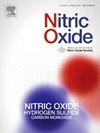Enhancing S-nitrosoglutathione reductase decreases S-nitrosylation of ERO1α and reduces neuronal death in secondary traumatic brain injury
IF 3.2
2区 生物学
Q2 BIOCHEMISTRY & MOLECULAR BIOLOGY
引用次数: 0
Abstract
Traumatic brain injury (TBI) has the highest incidence of all common neurological disorders, along with high mortality and disability rates. Pathological conversion of excess nitric oxide (NO) to S-nitrosoglutathion (GSNO) after TBI leads to high S-nitrosylation of intracellular proteins, causing nitrative stress. GSNO reductase (GSNOR) plays an important role by regulating GSNO and SNO-proteins (PSNOs) and as a redox regulator of the nervous system. However, the effect of GSNOR on protein S-nitrosylation in secondary brain injury after TBI is not clear. In vivo TBI model was established in male C57BL/6 mice via controlled cortical impact (CCI). Neuron-targeted GSNOR-overexpression adeno-associated virus (AAV) was constructed and administered to mice by stereotactic cortical injection. The results showed that NO, GSNO, neuronal protein S-nitrosylation and neuronal death increased after TBI, while the level and activity of GSNOR decreased. Overexpression of GSNOR by AAV decreased GSNO and NO and improved short-term neurobehavioral outcomes in mice. GSNOR overexpression can reduce endoplasmic reticulum stress and neuronal death by reducing the S-nitrosylation of ERO1α via H2O2 generation and plays a neuroprotective role. In conclusion, our results suggest that GSNOR regulating S-nitrosylation of ERO1α may participate in neuronal death, and overexpression of GSNOR in neurons after experimental brain injury alleviates secondary brain injury. Our research provides a potential therapeutic approach for the treatment of TBI.
增强 S-亚硝基谷胱甘肽还原酶可降低ERO1α的 S-亚硝基化并减少继发性创伤性脑损伤的神经元死亡
在所有常见的神经系统疾病中,创伤性脑损伤(TBI)的发病率最高,死亡率和致残率也很高。创伤性脑损伤后,过量的一氧化氮(NO)病理性转化为 S-亚硝基谷胱甘肽(GSNO),导致细胞内蛋白质高度 S-亚硝基化,从而引起硝化应激。GSNO 还原酶(GSNOR)通过调节 GSNO 和 SNO 蛋白(PSNO)以及作为神经系统的氧化还原调节器发挥着重要作用。然而,GSNOR 对创伤后继发性脑损伤中蛋白质 S-亚硝基化的影响尚不清楚。通过可控皮质冲击(CCI)在雄性 C57BL/6 小鼠中建立了体内 TBI 模型。构建了神经元靶向 GSNOR 表达的腺相关病毒(AAV),并通过立体定向皮层注射给小鼠。结果表明,创伤性脑损伤后,NO、GSNO、神经元蛋白S-亚硝基化和神经元死亡增加,而GSNOR的水平和活性降低。通过AAV过表达GSNOR可降低GSNO和NO,并改善小鼠的短期神经行为结果。过表达GSNOR可通过产生H2O2减少ERO1α的S-亚硝基化,从而降低内质网应激和神经元死亡,起到神经保护作用。总之,我们的研究结果表明,GSNOR调节ERO1α的S-亚硝基化可能参与了神经元死亡,而在实验性脑损伤后的神经元中过表达GSNOR可减轻继发性脑损伤。我们的研究为治疗创伤性脑损伤提供了一种潜在的治疗方法。
本文章由计算机程序翻译,如有差异,请以英文原文为准。
求助全文
约1分钟内获得全文
求助全文
来源期刊

Nitric oxide : biology and chemistry
生物-生化与分子生物学
CiteScore
7.50
自引率
7.70%
发文量
74
审稿时长
52 days
期刊介绍:
Nitric Oxide includes original research, methodology papers and reviews relating to nitric oxide and other gasotransmitters such as hydrogen sulfide and carbon monoxide. Special emphasis is placed on the biological chemistry, physiology, pharmacology, enzymology and pathological significance of these molecules in human health and disease. The journal also accepts manuscripts relating to plant and microbial studies involving these molecules.
 求助内容:
求助内容: 应助结果提醒方式:
应助结果提醒方式:


